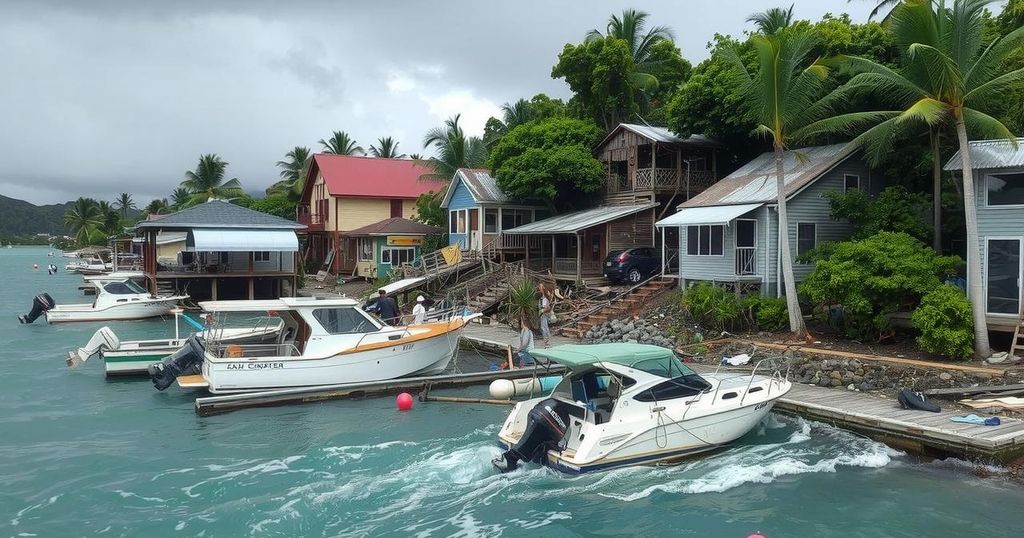Cyclone Chido has devastated Mayotte, resulting in a feared high death toll and extensive property damage. Initial reports suggest fatalities between 11 and 14, with many injured. Rescue efforts are complicated by infrastructural damage, and the cyclone’s impacts extend to nearby regions. Authorities are mobilizing resources for relief, highlighting the urgent need for assistance amid the crisis.
Significant concerns have arisen regarding the potential death toll in Mayotte, following the devastation wrought by Cyclone Chido during the recent weekend. French Interior Minister Bruno Retailleau reported a minimum of 11 fatalities, while local authorities initially indicated that 14 individuals may have lost their lives. Efforts to ascertain an accurate count of casualties and injuries are complicated by challenging conditions, with reports of nine individuals in critical condition among 246 wounded.
Minister Retailleau is set to travel to Mayotte alongside a contingent of 160 soldiers and firefighters, supplementing the 110 personnel already present on the islands in anticipation of the cyclone. Chido, having barreled through the southeastern Indian Ocean, has inflicted severe damage on Mayotte, which has been termed the most devastating cyclone to affect the territory in nearly a century. As the cyclone has now moved onto Mozambique, emergency officials there are anticipating that approximately 2.5 million residents could be impacted.
In Mayotte, rescue efforts are underway, but logistics have been hindered by infrastructural damage, including the impairment of airports and disruptions in electrical supply. Clean drinking water, which was already a scarce resource, has become even more critical. Approximately 320,000 residents of Mayotte were placed under lockdown as the cyclone approached, with wind speeds recorded at over 226 kilometers per hour causing extensive destruction, particularly in informal settlements.
Emergency medical supplies and personnel are being dispatched from La Réunion, and assessments are ongoing to determine the needs of both the emergency services and the general population. Currently, over 15,000 homes are without electricity, while communication has been significantly disrupted. The health infrastructure in Mayotte has also sustained considerable damage, raising concerns about medical service continuity.
The impacts of Cyclone Chido extended beyond Mayotte to the nearby Comoros islands, which experienced some flooding and damage but to a lesser extent. UNICEF has announced its engagement in relief efforts, focusing on restoring essential services for those affected by the cyclone. Experts have linked the intensity of Cyclone Chido to climate change, indicating it was exacerbated by abnormally warm waters in the Indian Ocean. Historical data parallels Chido’s strength with other devastating storms, further emphasizing the serious implications of climate change in this region.
Cyclone Chido represents a significant climatic event, impacting the French overseas territory of Mayotte with unprecedented severity. This cyclone has emerged as the most destructive in nearly a century for Mayotte, characterized by extreme wind speeds that have led to widespread infrastructural damage and human casualties. Climate change has been cited as a contributing factor behind the cyclone’s intensity, with experts pointing to elevated sea surface temperatures in the Indian Ocean. The humanitarian response is complicated by the isolated geography of Mayotte and the challenges posed by destroyed transportation networks and communication issues, impacting relief efforts in the immediate aftermath of the cyclone.
In summary, Cyclone Chido has had a profound and devastating effect on Mayotte, with significant loss of life and extensive damage to infrastructure. As rescue operations progress, challenges remain in assessing the full impact of the cyclone due to the extensive damage sustained by essential services and logistical impediments. The situation underscores the growing concerns surrounding the influence of climate change on the frequency and severity of extreme weather events in vulnerable regions.
Original Source: www.lemonde.fr






